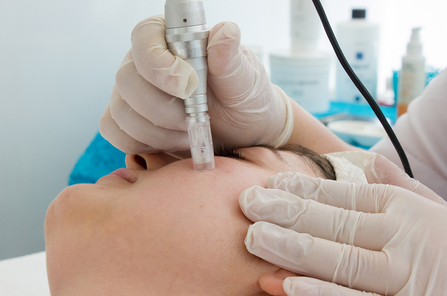
Dermapen
What is Dermapen?
Dermapen which is known as ‘mesoroller, micro needle therapy’ in the world, is a tool surrounded by needles which is made from tiny stainless steel placed on a cylindrical rotating drum. Dermapen is an application type made with a dermapen device which has 12 micro needles at its tip. The needles have lengths varying between 0,5mm – 2,5mm.
The products used in the application are hyaluronic acid, salmon DNA, stem cells, vitamins, antioxidants, proteins and minerals. Giving these effective substances directly to the skin and the stimulation of the skin increase production of the collagen and elastin on the skin and contribute to moisturize and renew the skin.
In Which Areas Can Dermapen Be Applied?
It can be applied to renew, moisturize and revitalize the skin, tighten the fine skin lines, reduce the scars on the skin (acne scars, strias, burn marks, etc.), to revitalize the hair in hair loss and to face, neck and low-neck areas.
What are the Benefits of Dermapen Application?
With Dermaroller treatment, it’s aimed to open micro channels on the skin (scars occurred with the needle tip) and tighten the fine skin lines with healing of the wound and reduce the scars on the skin (acne scars, strias, burn marks, etc.). It’s also provided the absorption of the topical applications. After the Dermaroller treatment, the production of elastin, collagen and hyaluronic acid which give volume and fullness to the skin increases. As a result, it contributes the improvement in skin surface, texture and colour of the skin and moisturizing and renewing the skin. It helps to increase the quality of the skin, reduce the loss of the elasticity of the skin, prolapse and scars. In hair treatments, it contributes to strengthen the hair bulb, to the formation of a healthier hair structure with volume.
Who Should Avoid From Dermapen Application?
Dermaroller/Dermapen application cannot be applied to those with facial paralysis, cancer patients, diabetics, those who have blood coagulation problem, cardiac patients requiring multiple medicine treatment and those who have active wound or infections in the area to be treated. The procedure can be applied to the pregnant women with a written approval of the doctor. The procedure cannot be applied to minors without their parents alongside.
What are The Periods and Stages of Dermapen Application?
While getting started application, to the area where the application is to be performed, the local anaesthetic cream is rubbed off and the area is narcotised and with the special antiseptic liquid, the area is cleaned. Once the medicine that the skin needs is decided, the procedure starts. The application procedure is done with Dermaroller/Dermapen. Due to the application, micro channels are opened in the treated area. These micro channels are considered as a wound by the skin and the skin’s own repair mechanism is naturally stimulated. These micro channels provide that the cream or solution applied topically will penetrate the skin. At the end of the application, soothing creams and sunscreen creams are applied. Number of the application sessions may vary according to the treated area and skin type. It takes approximately 4-10 sessions (if necessary, the number of sessions can be increased). Session intervals are minimum 15-21 days. Duration of the application sessions is approximately 30-45 minutes.
What are the Points to Be Considered Before and After Dermapen Application?
It’s recommended not to use aspirin, blood thinners, alcohol before the application. It’s recommended to come without make-up to the application. The treated area should not be touched. The person should not take a shower for 1 day after the application. Applications such as rub, peeling should not be applied, creams containing glycolic acid should not be used. The person should prevent from the sunlight and the recommended creams should be used.
What Are the Side Effects of Dermapen Application?
Side effects that can occur (redness, small bleeding at the entrance of needle, bruising, allergic reactions, burning, itching, oedema) pass approximately within 5-7 days. If there is a complication, the healing process may vary depending on the skin type of the person.
